The Early Years:
Well like all good stories, this one starts with a passion for motorcycle riding. In the summer of 1949, Bill VanTichelt entered his first motorcycle race at age 14. It was an AMA English Trials held at Lakeland Park in El Monte, California. Bill won first place on his 1948 Harley 125 and was hooked. In 1950, Bill bought his second bike, a 1950 Jawa 350 Twin from Eddie Kretz, Jr. at his pop's shop in Monterey Park. (Eddie and his father, Ed Kretz, Sr. are both AMA Hall of Famers).
Bill on his 500 AJS. 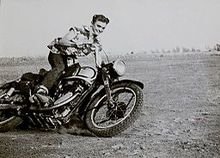
In 1951 while a senior at South Pasadena High School, Bill bought a 500cc AJS single from Lammy Lamoureaux's motorcycle shop in Glendale, California (Lammy is also an AMA Hall of Famer http://www.motorcyclemuseum.org). The day he bought the bike he met Vic Marshall who invited him to a meeting for the 20 Nite Owls (an off road motorcycle club). Through the Nite Owls, Bill met Barney Reagan who later offered him an evening job in a machine shop where Barney was foreman and thus, laid the ground work for Bill's interest in fabrication. The 20 Nite Owls leased 160 acres off the I5 near Castaic Junction known as the "Owl's Roost" for $100.00 a year. The club held monthly field meets such as TT races, motocross, dirt drags, slow rides, trials events and some AMA sponsored motocross races. Bill also raced in the AMA Hare & Hound runs in the Palmdale area. Alas, Bill headed off to college and could not afford to keep the "Ajay" repaired, so he traded it to Barney Reagan for a 1950 350cc Velocette MAC Single. Bill continued to race this bike which also led to his first customization, and a precursor of things to come. Bill cut off the rigid rear end of the bike and built a custom swing arm rear suspension. Bill then sold the Velo and bought a 200cc British Excelsior two stroke for $12.00 bucks (that's right twelve bucks). Bill also raced this bike at club events. Eventually, in 1956, Bill graduated from Cal Poly San Luis Obispo with a B.S. in Mechanical Engineering. Bill put his racing days essentially behind him and got a real job; the R&D Department of Frebank, Co., in Glendale, California. While there, Bill led the design and development of a snap action mechanism for a pressure switch that was utilized by NASA in the production of the Saturn V launch vehicle.
VanTech Engineering:
In 1960, Bill along with his father, Bill VanTichelt, Sr., formed VanTech Engineering, located in Visalia, California. VanTech initially began as a design and production shop of specialized hardware for the missile industry. However, in the early sixties, Bill became interested in karting and began applying his engineering background to build a faster kart. Bill developed muffler and a reed valve intake manifold for the McCulloch kart engines in 1961 which dramatically increased the speed and performance of the engines.
VanTech Reed Intake Manifold VanTech Kart Racer Steve Pound
VanTech Muffler
In 1962, Bill and his dad on a whim decided to build a small pseudo-dirt bike for Steve Pound one of their kart racers. Their self-designed VanTech frame was paired with bicycle wheels and one of the McCulloch kart engines with the souped-up VanTech manifold. This little prototype however, was the start of bigger things. In early 1963, Ray Hook, the creator of Blendzall Racing Oil, hired VanTech to create a special bike for one of Blendzall’s sponsored riders "Red" which bike went on to win every 100cc race it was entered into. This led Bill to create a second VanTech prototype which was sold to Frank Cancilla and raced by his son, Phil Cancilla in the Bay area.
The Very First VanTech for Blendzall 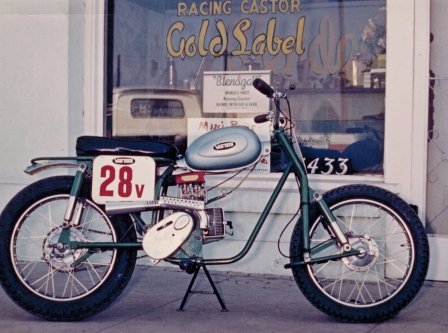 The Second VanTech Prototype
The Second VanTech Prototype 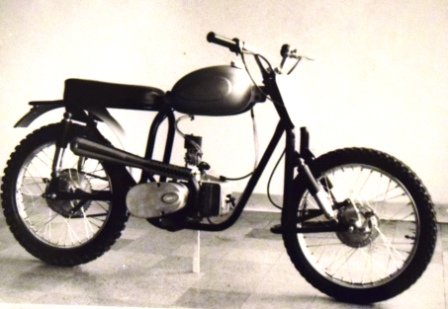
Bill went on to design, fabricate and build two VanTech production bikes: “The Scrambler,” an out-and-out racing machine powered by a McCulloch MAC9 kart engine (99cc to 125cc models fit the VanTech mounts) and the “Trials 80". This bike was identical to the Scrambler but was powered by a Yamaguchi (now known as Hodaka) motorcycle engine (originally 80cc). The Scrambler and the Trials 80 gained VanTech a reputation as a builder of sturdy, light and well-machined frames. Bill was a stickler for detail - all of the frames were hand-crafted and jig-built, for precise alignment, and the joints where the tubes meet were all milled to fit. The rear suspension was a conventional swing arm set-up and the front was leading link designed by Bill and inspired by Greeves. (Please see the 1964 Cycle World article available in the free literature "shop page" for more details).
The Original VanTech Scrambler Production Motorcycle 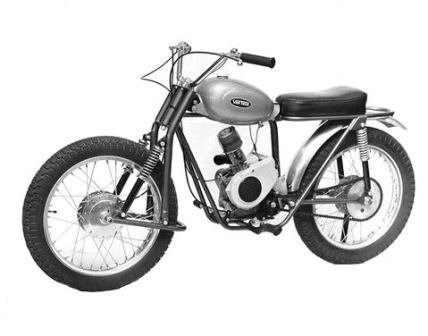 VanTech Leading Link Fork
VanTech Leading Link Fork 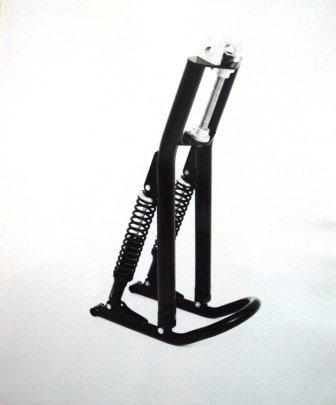
The Summer of '64:
During this time, Bill went on to construct eight 250cc VanTech motorcycles each one different - T.T., flat tracker, desert, and drag bikes using Yamaha, Ducati, Villiers, McCulloch and Montessa engines. Meanwhile, VanTech’s first factory sponsored rider, Joey Petz, went on to win practically every 100cc race he entered on the VanTech Scrambler. VanTech produced 200 of the first-series VanTech Scrambler motorcycles. At the time,VanTech was the only other American manufacturer of motorcycles aside from Harley Davidson. The bikes were considered well-made, fast and quite exciting to ride given their small-displacement engines.Ths was also the beginning of the VanTech Leading Link Fork which gave 6+ inches of travel and was about four pounds lighter than any telescopic fork then available.
Bill & VanTech Factory Sponsored Rider Joey Petz 1964 Bill VanTichelt & Joey Petz 2014 Early VanTech owned and raced by George Parmelee
1965-1966 The Grant-VanTech Conversion Kits:
Although Keith Kruser won the 100cc Amateur National Championship in 1965 on a VanTech Yamaha, the McCulloch engine (without a gearbox) was gradually losing its edge. In the fall of 1966, Bill developed the first VanTech conversion kit; a Universal Duplex 100cc frame. Dick MacCoon of Grant Industries (known for its famous Grant piston rings and steering wheels) contacted Bill to discuss joining forces to create what is now known as the "Grant-VanTech Kits". The first of its kind, the kits gave the rider the opportunity to convert their motorcycle to a scrambler, tt special, road racer or flat tracker using their own engine, wheels and forks. Bill also built another bike for Ray Hook of Blendzall Oil at this time, who was looking for a twin engine bike which became known as the VanTech "Widowmaker."
Grant-VanTech Conversion Kit 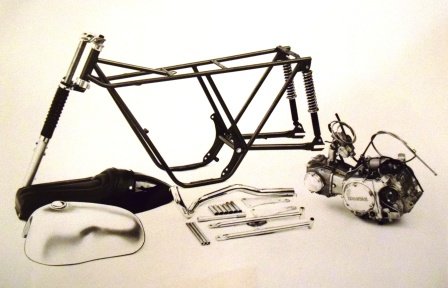 The VanTech Widowmaker twin kart engines
The VanTech Widowmaker twin kart engines 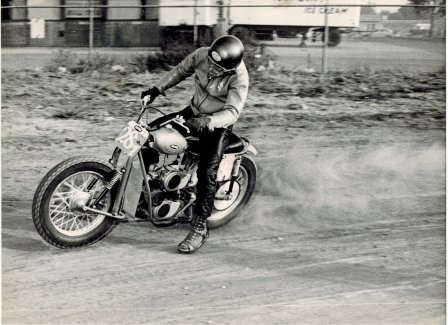
Shortly after the Van Tech Motorcycle kit program was merged into Grant Industries' operation in Los Angeles, California, Grant Industries decided that motorcycle helmets would be a compatible addition to their increasing product line. Given Bill’s mechanical engineering background, he was given responsibility for Grant's engineering activities. At the time, General Electric Corporation ("GE") was in the early stages of producing polycarbonate, an extremely strong and uniquely ductile thermoplastic material. The PR value created by the fact that the Apollo Astronauts were using Lexan helmets was also a benefit.
VanTech Roehr Bros.:
In 1968, the Grant-VanTech Kits were acquired by the Roehr Brothers (Duane, Gary and Ken Roehr and became known as the "VanTech-Roehr” line of frames, chassis kits and accessories. The VanTech conversion kits continued to be popular both on and off the raceway. In 1969, Terry Clark riding a VanTech Kawaski garnered a 1st place at the So. Cal. 3rd Annual Barstow to Vegas desert race and Mark Wilson earned a 1st Place Amatuer rider on his VanTech Hodaka by Roehr. In March of 1969, at the Trojan Speedway (see photo below), in the 100cc Experts class, four VanTechs entered and placed, first through fourth (Carl Byers,Wayne Hosaka, John Brown and Ray Vanderpool respectively). Eventually however, in July of 1973, after an amazing journey wherein VanTech left its indelible mark on the history of motocross racing, Roehr Bros. shut its doors for good. To this day, VanTech motorcycles remain highly collectible vintage American made bikes.